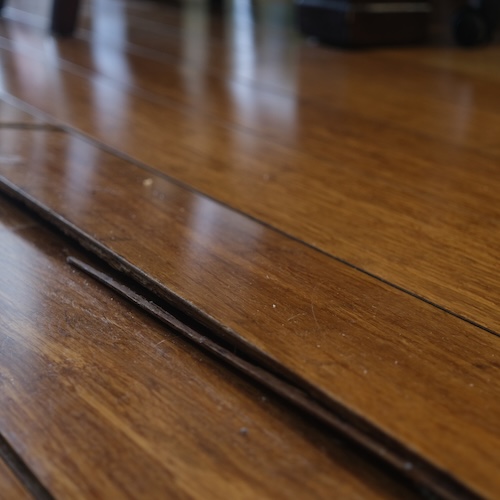Buying a house with uneven floors? What to consider
Contributed by Karen Idelson
Nov 2, 2025
•6-minute read

You’ve finally found your dream home. Not only does it have the right number of bedrooms, an updated kitchen, a good-sized yard, and plenty of natural light, but it’s in your price range and in a quiet neighborhood. But as you tour the home, you realize something is off. The floor seems a little uneven in areas. What now?
You don’t have to write it off immediately. Uneven floors are common, especially in older homes. While these floors do mean there’s probably some structural damage, it’s not necessarily at a dealbreaker level.
In this article, we’ll go over how to assess the risks and costs with professionals, what to consider before buying, and what can be done to fix uneven floors.
What causes uneven floors?
The term “uneven floors” covers a wide range of issues such as sagging, bouncing, buckling, or sloping. You can expect to find them in many homes that were built more than 15 years ago simply because of natural foundation shifting and settling.
As we said before, this isn’t necessarily a deal-breaker. But you should always have a home inspector look at the house to learn the extent of the problem. Let’s cover the three most common causes: too much moisture, structural or foundation issues, and ground movement.
Too much moisture
Water damage is the most common cause of uneven floors. The water can be getting in from a variety of sources, such as leaking pipes or groundwater intrusion, some of which are more difficult to fix than others. Moisture can quickly become a major problem when it damages wooden beams and subflooring.
Structural or foundation issues
Another common cause of uneven floors is structural or foundation damage. Unfortunately, it’s also usually the most expensive fix. Structural damage can be problems with bearing walls, framing, and beams. This can compromise weight distribution, which leads to warped floors. Foundation damage is a major threat to the safety of the home and can cause cracks or even breaks in flooring.
When there’s a structural issue with a home, you’ll probably see more than uneven floors. Keep an eye out for the following red flags when looking at a house:
- Windows and doors that stick
- Floors that sag or slope in one direction
- Bouncy floors
- Cracks in walls or ceilings
- Walls that seem to bow
If you find any of these, be sure to consult with a building professional or contractor to get to the bottom of the damage.
Ground movement
Minor ground movement over time is natural, especially in certain parts of the country. Unfortunately, your foundation might move with it. This is why ground is leveled and soil is compacted when homes are built, but sometimes this isn’t enough. If a home’s floors seem warped, but there’s no obvious structural damage, contact a floor specialist or contractor who specializes in sloped floors.
Things to consider before buying a house with uneven floors
If you’re committed to a home with uneven floors, consider these things before moving forward with a purchase.
1. Always hire an expert inspector
One of the most important steps in the home buying process is getting your dream home inspected, so you might want to consider having a home inspection contingency. This means that your purchase of the home depends on the result of a home inspection, and you won’t lose your earnest money if you decide to walk away from the sale.
Not only will an inspector check for uneven floors, but they’ll look for uncommon problem areas you might not think of, such as chimneys and crawlspaces. After a home inspection, you’ll get a repair cost estimate, which will help you figure out if pursuing the purchase is worth it.
2. Don’t get stuck with the repair bill
If uneven floors aren’t caught before purchase, the home buyer will be stuck with the repair costs. If a home inspection reveals major issues, you can negotiate the price or ask the seller to cover the costs of repairs. An inspection contingency also lets you walk away from the sale if the problems are severe.
3. Take the type of foundation into account
Your home repair costs will vary based on foundation type because some foundations are harder and more expensive to fix than others. For example, pier-and-beam foundations are cheaper to fix than slab foundations because they’re easier to access. In 2025, general foundation repair costs usually range between $2,225 and $8,126.
4. Additional structural fixes can add up
Keep in mind that home repair costs can very quickly add up. When fixing uneven floors, other issues might come to light. You might have to replace more than that one beam you know is the issue, or you might have related costs. It’s best to not take repair estimates at face value and make decisions based on higher costs.
5. Consult a local real estate agent
When facing the dilemma of uneven floors or considering a historic home whatever the state of its floors, it’s especially helpful to work with a local real estate agent who has similar experience with other homes in the area. They can probably introduce you to nearby trusted inspectors or contractors familiar with floor issues. An agent can also help you negotiate a better deal after an inspection, especially if you have a mortgage approval on hand when making an offer.
How do you assess the risk of buying a house with uneven floors?
As with many questions about buying a home, only the buyer can disease if the risks and costs associated with uneven floors are worth it.
If your heart is set on a house, get as much information as you can on it. Consult with a home inspector and other real estate professionals, and see if the seller has a history of home repairs. You’ll want a solid understanding of the extent of the damage and repair costs.
Minor foundation issues or minimal water damage from leaky pipes can easily be fixed by the seller. On the other hand, if structural damage is so great that the home is unsafe, it’s probably not a worthy investment.
How do you fix uneven floors?
The process to fix uneven floors in a home depends on what kind of damage you’re looking at. For instance, water damage will be handled very differently than natural settling due to ground movement over the decades. Before fixing anything, a home inspector or other professional will identify the root cause of water damage, structural or foundation issues, ground movement, or something else.
A small amount of unevenness without major structural issues can usually be corrected with sanding, leveling compounds, or shimming. More serious problems might involve replacing damaged subflooring, reinforcing floor joists, or even replacing the foundation in severe cases.
Uneven floors aren’t a problem you should try to fix on your own. Consult with professionals to make sure your home is safe and learn how to prevent future damage.
FAQ
Still not sure about that house with an uneven floor? Here are a few common questions you might ask.
How much of an uneven floor is acceptable?
There’s no single standard for an uneven floor — it depends on your budget, your priorities and your commitment to the home. If the unevenness is minimal and not due to major structural issues, it’s probably worth it. But if you’re looking at five figures of repairs and the house is unsafe at the moment, it might not be.
How much does it cost to fix sloping floors?
The cost to repair sloping floors varies widely. A minor surface-level issue might cost anywhere from $300 to $2,000, but major repairs such as structural reinforcements can easily be tens of thousands of dollars.
Can you prevent uneven floors?
Uneven floors can be hard to avoid if a house is older, but you can minimize or even prevent damage with drainage improvements or spout installation. You might also want to add further reinforcements to the floor, especially if you have a crawlspace.
The bottom line: Follow the floor’s slope to find the real problem
Don’t let uneven floors stop you from buying your dream home, but don’t overlook the potential risks and costs that come with them, either. Uneven floors don’t always mean dangerous structural damage or monumental costs. If you’re serious about a home, get it inspected and discuss the results with professionals you trust — it’s the best way to make an informed decision.
If you’re committed to a home with uneven floors and want to negotiate price with a seller, you’re better off with a mortgage approval ready. Take the next step in your home buying journey and get started today.

Kate Friedman
Kate is a contributing writer and publisher who has worked with Rocket since 2022. She also works as a middle-school interventionist and has taught personal finance and life skills to high-schoolers.
Related resources

7-minute read
A guide to the home inspection contingency
A home inspection contingency allows buyers to respond to results within a specific time frame. Learn how to successfully navigate and reply to an inspection.
Read more
9-minute read
The final walk-through: Checklist of what to look for
Our final walk-through checklist can help secure your peace of mind before closing. Verify repairs and ensure your new home is move-in ready.
Read more
9-minute read
Selling a house as is: What to know
Learn what it means to sell your house as is, the pros and cons, and how to attract serious buyers without making costly repairs.
Read more